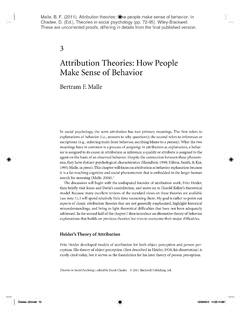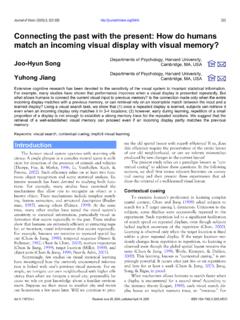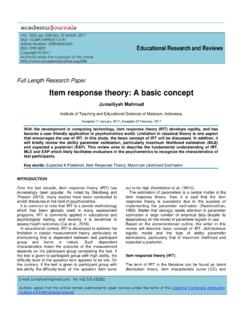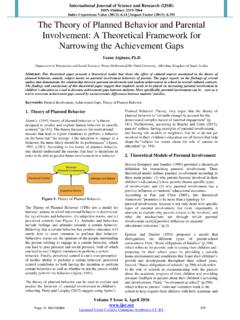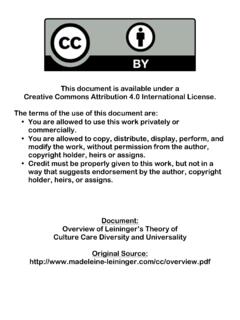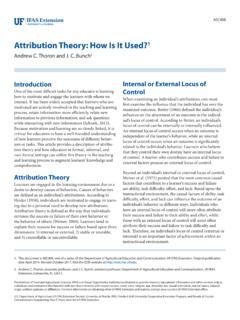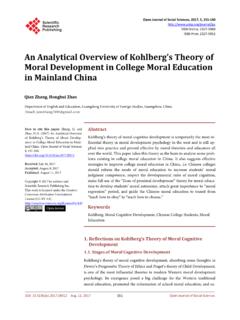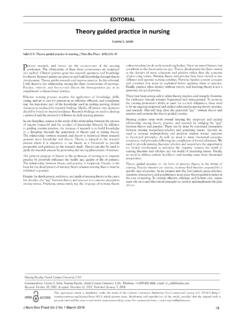Transcription of Attribution Theories: How People Make Sense of Behavior
1 In social psychology, the term Attribution has two primary meanings. The first refers to explanations of Behavior ( , answers to why questions); the second refers to inferences or ascriptions ( , inferring traits from Behavior , ascribing blame to a person). What the two meanings have in common is a process of assigning: in Attribution as explanation, a behav-ior is assigned to its cause; in Attribution as inference, a quality or attribute is assigned to the agent on the basis of an observed Behavior . Despite the connection between these phenom-ena, they have distinct psychological characteristics (Hamilton, 1998; Hilton, Smith, & Kin, 1995; Malle, in press).
2 This chapter will focus on Attribution as Behavior explanation because it is a far-reaching cognitive and social phenomenon that is embedded in the larger human search for meaning (Malle, 2004).1 The discussion will begin with the undisputed founder of Attribution work, Fritz Heider, then briefly visit Jones and Davis s contribution, and move on to Harold Kelley s theoretical model. Because many excellent reviews of the standard views on these theories are available (see note 1), I will spend relatively little time recounting them. My goal is rather to point out aspects of classic Attribution theories that are not generally emphasized, highlight historical misunderstandings, and bring to light theoretical difficulties that have not been adequately addressed.
3 In the second half of the chapter I then introduce an alternative theory of Behavior explanations that builds on previous theories but tries to overcome their major s theory of AttributionFritz Heider developed models of Attribution for both object perception and person per-ception. His theory of object perception (first described in Heider, 1920, his dissertation) is rarely cited today, but it serves as the foundation for his later theory of person Theories: How People Make Sense of BehaviorBertram F. MalleTheories in Social Psychology, edited by Derek Chadee 2011 Blackwell Publishing 7210/28/2010 11:09:13 AM10/28/2010 11:09:13 AM Attribution Theories: How People Make Sense of Behavior73 Heider attempted to solve one of the core philosophical problems of phenomenology: the relation between sensory information and real objects.
4 That is, he asked how it was pos-sible that humans perceive qualities of objects in the world even though all they have are sensations in the mind. Heider argued that real objects shape media such as air pressure, light reflections, and Sense organs. These media have a considerable degree of variance (for one thing, they reflect many real objects), but the perceptual apparatus reconstructs real objects from their characteristic effects on the media. Heider labeled this reconstruction Attribution a process that generates inferences of the relatively invariant qualities of things from the characteristic variance patterns they cause in their media.
5 Perceivers faced with sensory information thus experience perceptual objects as out there because they attribute the sensory data to their underlying cause in the world (Heider, 1920).2 After his early work on object perception Heider turned to the domain of social interac-tions, wondering how People perceive each other in interaction and especially how they make Sense of each other s Behavior . Heider proposed that a process of Attribution is involved in person perception as well, but he recognized that person perception is more complex than object perception due to the manifold observational data available and the various causes ( , beliefs, desires, emotions, traits) to which these data can be attributed.
6 In addition, it was clear to Heider that persons are very different targets of perception than inanimate objects. Persons are perceived as action centers and as such can do something to us. They can benefit or harm us intentionally, and we can benefit or harm them. Persons have abilities, wishes and sentiments; they can act purposefully, and can perceive or watch us (Heider, 1958, p. 21). Note that Heider repeatedly refers to the intentionality of persons, which he considered a core assumption in the conceptual framework that underlies social perception.
7 With the help of such concepts as intentionality and the inference of wishes, purposes, sentiments, and other mental states, Heider argued, perceivers bring order and meaning to the massive stream of behavioral though in one Sense person perception is like object perception a process of extracting invariance out of variance Heider emphasized two distinct features of person perception. The first is that in the social domain, variance refers to the agent s stream of ongoing Behavior and invariance refers to the inferred perceptions, intentions, motives, traits, and sentiments.
8 Heider (1958) sometimes used the term disposition to refer to these invariances, and even though he occasionally referred to traits and abilities when talking about dispositions ( , pp. 30, 80), he considered motives, intentions, sentiments .. the core processes which manifest themselves in overt Behavior (p. 34). It was the agent s motives that occupied a special role in Heider s model: The underlying causes of events, especially the motives of other persons, are the invariances of the environment that are rele-vant to [the perceiver]; they give meaning to what he experiences (Heider, 1958, p.)
9 81; emphasis added). In social perception, then, Heider s terms disposition and invariance referred primarily to mental second distinct feature of person perception is that when People perform a causal ( , attributional) analysis of human Behavior , their judgments of causality follow one of two conceptual models (Heider, 1958, chap. 4). The first is a model of impersonal causality, applied to unintentional human behaviors (such as sneezing or feeling sad) and physical events (such as waves splashing or leaves falling). The second is a model of personal causality, 7310/28/2010 11:09:13 AM10/28/2010 11:09:13 AM74 Bertram F.
10 Mallewhich is invoked whenever a human agent performs an intentional action (such as clean-ing the kitchen or inviting someone to dinner). Personal causality, Heider wrote, refers to instances in which p causes x intentionally. That is to say, the action is purposive (Heider, 1958, p. 100).Unfortunately, subsequent Attribution research misrepresented both of these crucial features of person perception. First, even though mental states make up the majority of what Heider subsumed under dispositional properties (Heider, 1958, pp. 31 34, chap.)
